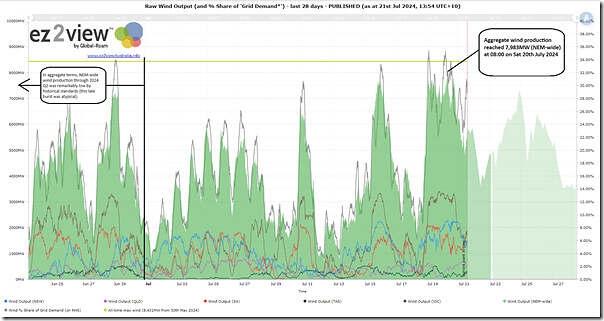Just over a week ago we posted these ‘Final figures for wind production through 2024 Q2′ … which showed that:
1) Apart from a few isolated bursts in NEM-wide wind production;
2) The aggregate levels across 2024 Q2 were disconcertingly low … lowest since the ‘wind drought’ of 2017 Q2 (seven years earlier).
However in recent days (early in 2024 Q3) we have seen the wind return closer to the (seasonally higher) levels we expect to see at this time of year.
… for instance, yesterday we saw Yoska Hernandez write ‘Strongest winds in 1 to 3 years impacting parts of southeastern Australia’ at Weatherzone.
To look at what that has meant in terms of production from wind farms across the NEM, we refer to a pre-configured query in the ‘Trends Engine’ behind our ez2view software, we see how aggregate NEM-wide wind production fared:
Those with a licence to the software can open their own copy of this query here.
In this chart we see that:
1) Already in July 2024 we’ve had few periods of low wind yield … and no sustained periods (unlike in 2024 Q2)
2) Instead we’ve seen a few high bursts…
3) … and in particular since late on Thursday 18th July 2024:
(a) which peaked just under 8,000MW … so only 500MW away from the all-time maximum set on Thursday evening 30th May 2024;
(b) and which has disrupted some air travel, for instance (along with the CrowdStrike issues)
4) With AEMO’s current forecasts looking at aggregate wind production levels at least as high as 3,500MW for another week.
Does that mean the ‘wind drought’ of 2024 Q2 is definitely over?



No, or at least I think it is still too early to call it. The trailing 30 day levels are still below that of last year. The other factor in this wind drought weather pattern, a lack of rain particularly over Tasmania, is still resulting in Tas Hydro using fossil gas for generation and importing significantly from Victoria. Even though the key catchments in Tasmania seem to have good rain in the last couple of weeks, it would appear the catchments are still a bit dry and the dam levels low for Tas Hydro to want to return to normal operations. While this situation continues, it will result in higher prices in the southern regions of the NEM.
Here’s hoping we continue to see good wind levels and rainfall over southern Australia.